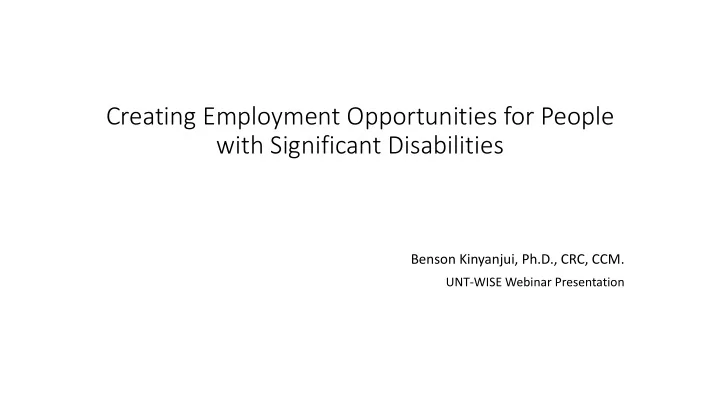

Creating Employment Opportunities for People with Significant Disabilities Benson Kinyanjui, Ph.D., CRC, CCM. UNT-WISE Webinar Presentation
Significant Disabilities • Definitions: • A severe physical or mental impairment which seriously limits one or more functional capacities in terms of an employment outcome • Limited ability to provide for own basic life sustaining needs • Includes • Developmental disability, intellectual disability, brain injury, autism, severe behavior and emotional disturbance, mental health, speech impairment, and multiple disabilities
Why Employment? • A vast majority of PWD want to work • Natural human needs • Empowerment • Benefits of working • Self esteem and sense of worth • Independence • Social responsibility • National/global economy • Unemployment among PWD • Perpetuates circle of poverty and disease • Is costly
Employment Rates Among PWD • 2017 Bureau of Labor Statistics • Employment • 34.3% of PWD employed (73.6% non-disabled people employed) • 32% employed part-time • 18.7% of PWSD were employed • Unemployment • 3.8% for general population • 9.2% for PWD: • 85% of PWDD and PWID unemployed
Employment Rates Among PWD data Figure 1. 2015 E mployment R ate Self- care difficulty, 15.4% Hearing difficulty, 50.7% Vision difficulty, 41.0% Independent living difficulty, 16.0% Ambulatory difficulty, 24.1% Cognitive difficulty, 24.8% Any disability, 34.3% No disability, 73.6% 0% 10% 20% 30% 40% 50% 60% 70% 80% 90% 100%
Barriers to Employment • Employer attitudes • Safety, liability, etc. • Family/societal attitudes • Overprotection, etc. • Lack of skills/aptitudes/abilities • Emphasis on the DIS-ability • Lack of opportunity and support to get a job • VRC’s ineffective/conventional placement approaches • Transportation
There is Good News • Unemployment rate for people with a disability has been decreasing since 2011 • From 10.5 in 2016 to 9.2% in 2017 • 343,000 new workers with disabilities took jobs in 2016, four times as many as the year before. • More large corporations hiring PWD • Walmart, Kroger, Joanne Fabrics, etc., started the trend • Other corporations include JP Morgan Chase, Pepsi, UPS, SAP, Ernst & Young, IBM, Starbucks, and Walgreens
Reasons Behind the Trend pt 1 • Increased public awareness/acceptance of PWD • Increased positive media representation • Inclusion of PWD in TV shows, ads, and movies • Employers realizing the benefits of employing PWD • Improves corporate image • Increases revenue • Proven research on those benefits • Fifth Quadrant Analytics Report • RoD Group corporate profitability rating • Institute for Corporate Productivity (i4cp) Market Performance Index (MPI)
Reasons Behind the Trend pt 2 • Highlights by leading corporate media • Forbes (2015) • The Globe and Mail (2015) • The Economist, WSJ, BBC, Barclays • RODI is a traded note on NYSE • Successful initiatives • Project SEARCH • Bridges from School to Work. • Employer Assistance and Resource Network on Disability and Inclusion (EARN) • RespectAbility • Autism Workforce
Top 5 Reasons for Hiring PWSD • Support organizational culture • Support diversity and integration • “It is the right thing to do” • Talent matches open position • Support corporate social responsibility
Strategies and Approaches • Current corporate trends have laid the groundwork • Less time spent convincing employers that PWD can work • Focus on advantages and benefits to employer • “Have you hired any PWD?” • Proactive approach • Focus beyond existing positions into creating new ones • Observing/evaluating jobs, and job descriptions • Isolating/bundling lower level tasks from several high level positions • Being knowledgeable regarding risk, liability, and safety requirements • Insurance coverage, where necessary
Creating Employment pt 2 • Vocational Innovation • Observing for and identifying uncovered tasks • Example 1: Veronica and the coffee shop • Position benefits employer by increasing revenue • Example 2: James at the assembly line • Position benefits employer by increasing productivity • Examples of other potential, unexplored options • Yard Inspector (?) • Exam proctor (?)
Footnote • Definition of Employment: • Working in an integrated job setting in the workforce at competitive wages (at least minimum wage) and benefits, and where employees with disabilities work alongside others who do not have disabilities, and have the same opportunities to participate in job and social activities as other company employees (APSE). • Being self-employed in entrepreneurial business ventures driven by individual interests and talents. • Traditionally based in workshop-type settings that are separated from mainstream workers and permitted to pay less than minimum wage. • Fully integrated job settings at fair wages.
Questions/Comments
References • Autism Workforce (n.d.). Creating an autism-ready workplace Retrieved from http://autismworkforce.com/ • Employer Assistance and Resource Network (n.d.). Learn how EARN can help employers tap the benefits of disability diversity! Retrieved from http://www.askearn.org/ • Gurchiek, K. (2018). BLS: Jobless Rate for People with Disabilities Decreases. Society for Human Resource management. • Project SEARCH (n.d.). Preparing young people with significant disabilities for success in integrated, competitive employment. Retrieved from https://www.projectsearch.us/ • Smith F.A., & Shepard, J. (2017). Data Note: Employment Rates for People With and Without Disabilities. American Community Survey, 1-2. • US Bureau of Labor (2017) Disability Employment Statistics. Retrieved from https://www.dol.gov/odep/topics/disabilityemploymentstatistics.htm
Recommend
More recommend